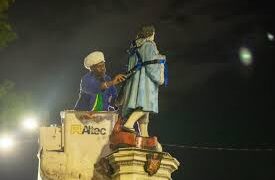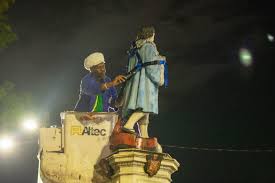Trinidad and Tobago has taken a significant step in re-examining its colonial past by removing statues of Christopher Columbus from prominent locations in its capital cities. The move is part of a broader national initiative aimed at reconnecting with the country’s roots and reinterpreting its historical narratives.
The decision comes after years of advocacy by citizens, scholars, and cultural activists, who argued that the monuments represented a painful legacy of colonization rather than a celebration of national heritage.
One of the statues, located in a public square in Port of Spain, had long been a subject of protest and had been vandalized multiple times. On the day of its removal, the statue’s head was draped with a decorative covering—an act many interpreted as a symbolic gesture of dissent.
This action is in line with recent efforts by the government to reassess national symbols. Last year, authorities announced plans to redesign the country’s coat of arms, marking the first major change to the emblem since Trinidad and Tobago gained independence in 1962.
These measures reflect a growing movement within the Caribbean to critically engage with the region’s colonial history and create public symbols that resonate more deeply with contemporary identity and values.



















